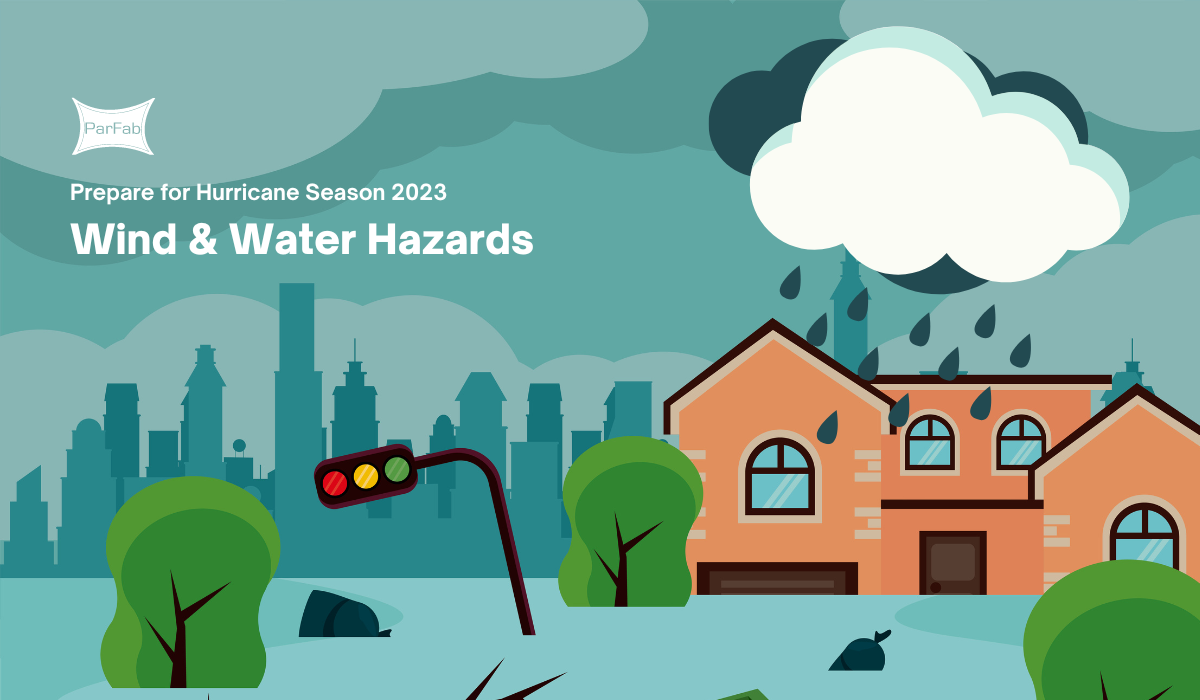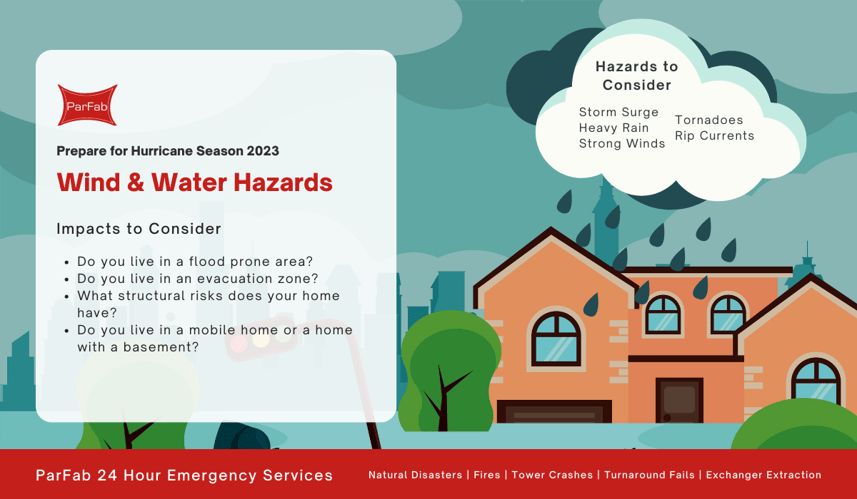3 min read
What's the Risk? How Storm Wind & Water Hazards Impact Your Area
ParFab Companies
August 9, 2023 11:43:10 AM EDT

Hurricanes and tropical storms extend beyond coastal areas and its category is not the determining factor for its aftermath. Wind and water can cause devastating effects that stretch hundreds of miles inland.
In this blog, we'll cover a few things that we find are important to know about storm hazards and risks. These things include the likelihood of it flooding in your region, how to find out if you're residing within an evacuation zone and how to pinpoint any vulnerabilities in your home's structure.
- What types of storm hazards should I be aware of?
- Do I live in a flood-prone area?
- Do I live in an evacuation zone?
- What are my structural risks?
What types of storm hazards should I be aware of?
Although hurricanes present the most significant risk to both life and property, tropical storms and tropical depressions can also cause significant damage. The key dangers associated with tropical cyclones, encompassing tropical depressions, tropical storms, and hurricanes, consist of storm surge flooding, extensive inland flooding due to heavy rainfall, destructive winds, tornadoes, as well as elevated surf and dangerous rip currents.
Storm Surge
Storm surge refers to the water propelled toward the shoreline by the swirling winds of a storm, and throughout history, it has been accountable for the most significant loss of life during hurricanes. This elevation in the water's level has the potential to lead to extensive coastal flooding, resulting in the immersion of whole regions, structural harm to buildings, and the erosion of roads. The reach of storm surge can extend several miles inland, particularly along bays, rivers, and estuaries.
For more information on storm surges, check out the NHC's Storm Surge Hazard Maps.
Flooding
The considerable volume of rain that any hurricane or storm can cause has demonstrated its dangerous potential through prolonged flooding episodes and abrupt instances of flash flooding. Residences, commercial establishments, and roadways can become submerged, hindering travel and evacuation efforts, while posing a life-threatening risk. Moreover, floodwaters can harbor perilous bacteria, chemicals, wildlife, and other hazardous debris. Extraordinary rainfall from hurricanes and storms can even overwhelm those regions typically unaffected by flooding. These floods can materialize far inland, spanning hundreds of miles, and endure for several days following the passage of the storm.
Rip Currents
Even when the beach appears to have pleasant weather, waves generated by distant storms have the potential to generate dangerous rip currents and turbulent surf, affecting shorelines situated a considerable distance away. It's essential to recognize that favorable conditions on the beach do not necessarily indicate safety in the ocean. Remarkably, storms located over 1,000 miles away can still instigate significant consequences.
Strong Winds
Powerful winds of hurricane force have the capacity to inflict harm upon homes and other structures, varying from mild to catastrophic outcomes. The consequences of wind damage encompass all regions experiencing power and communication blackouts, alongside the toppling of trees and the obstruction of roads by debris. Objects such as signs, roofing materials, and various items left outdoors can transform into airborne projectiles amid hurricanes and strong storm winds. Notably, mobile homes are particularly susceptible to wind-induced destruction.
Tornadoes
Do I live in a flood-prone area?
Individuals residing in regions susceptible to flooding face heightened vulnerability to the effects of hurricanes. It's crucial to determine the flood risk in your vicinity and devise appropriate preparations. Even if your residence isn't situated within a designated flood zone, it's essential to recognize that the substantial rainfall accompanying hurricanes can trigger flooding in areas not conventionally predisposed to such occurrences.
If you're wanting more information about flooding and flood zones, check out these resources: Understanding Flood Zones and Coastal Flood Exposure Mapper.
Do I live in an evacuation zone?
Make sure to find out whether your residence falls within a storm surge evacuation zone. This assessment will shed light on your susceptibility to storm surge, and its importance will be paramount when devising an evacuation strategy.
Not sure if you live in an evacuation zone? Find your evacuation zone here!
What are my structural risks?
Examine whether your residence possesses any vulnerabilities that might pose a life-threatening risk during a hurricane. Have your exterior doors and garage door been reinforced to withstand hurricanes? Are storm shutters in place? Certain features of your home can be fortified to enhance its resistance to hurricane impacts, while others may not be modifiable. It's worth noting that mobile homes are especially prone to damage from hurricane-force winds, whereas basements are particularly susceptible to storm surge and flooding.
ParFab Emergency Services
In the event of a natural disaster emergency, like a hurricane or tropical storm, ParFab offers 24 hour callout for repair and replacement services. ParFab is the worldwide leader in end-to-end fabrication & field services and was awarded the 2023 Contractor Safety Achievement Award.
Click below to learn more about our emergency field services or to get in touch with our emergency call out team!
References: https://www.noaa.gov/know-your-risk-water-wind



